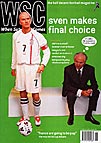 After 70 years, Tooting & Mitcham United are moving home. Andy Lyons reports
After 70 years, Tooting & Mitcham United are moving home. Andy Lyons reports
A Ryman League First Division fixture between Tooting & Mitcham United and Wealdstone wouldn’t normally draw a thousand people, or anywhere near. Most of the crowd on April 20 had come specifically to see the last competitive match at Sandy Lane, Tooting’s home since 1932 and the last of the big non-League grounds left in London. Chairman John Buffoni has taken the brave step of striking a business deal with Ron Noades, as a result of which the club will begin next season at a new stadium built on Crystal Palace’s old training ground two miles away across south London.
The sale of Sandy Lane to developers has enabled the club to stay in business, but many will be sad to see it go the way of other famous grounds from the heyday of the amateur Isthmian League. Green Pond Road, home of Walthamstow Avenue since 1900, disappeared 12 years ago when the club was swallowed up as part of the multiple mergers that created Dagenham & Redbridge. Dulwich Hamlet moved out of the vast Champion Hill in 1991 and are now based at a much smaller ground with the same name. Kingstonian, in administration after relegation from the Conference, left their old ground, Richmond Road, in 1989 for Kings Meadow, which is itself attracting interest from the aforementioned Ron Noades, seeking a new home for Brentford.
Today’s visitors, Wealdstone, have fallen a long way since winning the non-League Double of Conference and FA Trophy in 1985, and no longer have a home of their own, a fact touched on by some Tooting fans: “We’ve got two grounds, you’ve got none.” The hardcore home support gather at the Bog End on crumbling, weed strewn concrete. Over in one corner a perplexed-looking couple with a pair of greyhounds seem to have come to the wrong stadium. Part of an old sign, reading “ting & Mit”, lies among the bushes behind the terracing. Clippings are taken from among the verdant growth, but plants that have absorbed 20 years of disappointment and crushed ambition in their roots would surely kill a garden.
Tooting’s finest hour was in January 1959 when Sandy Lane held 14,500 for an FA Cup third round tie against Nottingham Forest. (Two seasons earlier the ground record had been set when 17,500 packed in for a Cup tie with QPR – people must have been smaller in the 1950s.) Tooting were two up that day before being pegged back by an own goal and a hotly contested penalty, and Forest went on to win the Cup. One of their players, Roy Dwight, uncle of Elton John, was Tooting’s manager when they had their best ever Cup run in 1975-76, going out to Bradford City in the fourth round after beating Swindon in a replay.
From the end of the Seventies the club went into steep decline with two relegations, offset slightly by promotion to the Ryman First Division last season. Crowds rarely topped 150 when Buffoni stepped in nine years ago, replacing an ageing club committee – “the relics from the 1950s” according to fans at today’s game. A merger with neighbours Carshalton Athletic had been considered before the decision was taken to move to a new site.
Tooting take the lead in the first half, miss three easy chances, then have what seems to be a good goal ruled offside. At the start of the second half Wealdstone get a penalty, though the referee ignores advice to “Take it yourself” from the home support. Tooting hit back to lead 3-1, and sections of the crowd relax enough to focus on arguing about offside with a linesman, who shouts a reply, explaining his decision in unarguable terms.
Wealdstone get a second goal late on, but Tooting hang on. Kids swarm on for autographs and a rueful observer wonders if his life has taken the right turn: “It’s almost worth having a family just so you’d have an excuse to get on the pitch at a time like this.” Cheers go up among a small knot of people with a radio – Dagenham & Redbridge, “the Frankenstein club”, have lost.
From WSC 184 June 2002. What was happening this month